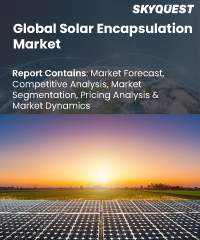
Product ID: SQMIG55F2035

Report ID:
SQMIG55F2035 |
Region:
Global |
Published Date: March, 2024
Pages:
182
|
Tables:
65 |
Figures:
75
Global Solar Encapsulation Market size was valued at USD 3.13 Billion in 2022 and is poised to grow from USD 3.40 Billion in 2023 to USD 6.63 Billion by 2031, at a CAGR of 8.7% during the forecast period (2024-2031).
The global solar encapsulation market experienced a surge in demand due to the increasing adoption of solar energy as a clean and sustainable power source. The growing installations of solar panels in residential, commercial, and utility-scale projects globally have been a key driver for the market. Solar module back sheets consist of multiple layers of barrier films and adhesives, serving a crucial role in safeguarding solar cells from various environmental factors like moisture, UV exposure, and performance-related challenges. Additionally, they contribute to improving solar module efficiency, thereby aiding in the reduction of overall module costs.
Encapsulation films play a vital role in protecting and ensuring the reliability and performance of solar cells. Their primary function is to maintain optical and electrical transmissivity while preventing moisture infiltration. Encapsulants offer opportunities for enhancing efficiency in the solar module manufacturing process, serving as a critical step in solar cell production. Without effective encapsulation, even top-tier solar cells cannot yield high-quality solar modules. Proper encapsulation not only extends the lifespan of solar cells but also enhances their durability. Ensuring the quality and longevity of the product is essential for customer satisfaction, underscoring the importance of encapsulation in solar module manufacturing. The growing trend of urbanization has led to increased demand for solar panels, consequently driving the market for encapsulation. Furthermore, the rising need for solar lighting solutions for road dividers and streets creates substantial opportunities for the solar encapsulation market.
Developing encapsulation materials that can withstand long-term exposure to harsh environmental conditions and maintain performance over time is a challenge. Supply chain disruptions and fluctuations in raw material prices can also impact the market stability. The solar encapsulation industry heavily relies on raw materials like ethylene vinyl acetate (EVA) and encapsulant films. Any disruptions in the supply chain can hinder production and affect market dynamics. Furthermore, changes in government policies, including tariff structures, incentives, and regulations related to solar energy, can have an impact on the market and investment decisions in the solar encapsulation sector.
Our industry expert will work with you to provide you with customized data in a short amount of time.
REQUEST FREE CUSTOMIZATIONWant to customize this report? This report can be personalized according to your needs. Our analysts and industry experts will work directly with you to understand your requirements and provide you with customized data in a short amount of time. We offer $1000 worth of FREE customization at the time of purchase.

Product ID: SQMIG55F2035